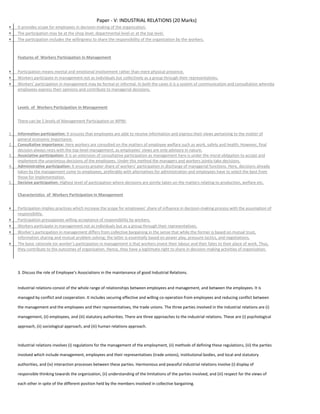This document discusses industrial relations and trade unions in three paragraphs:
1) It provides background on industrial relations in the UK, noting that trade union membership makes up 24.7% of the workforce on average, but is higher in the public sector. There are estimated to be 6.5 million trade union members in the UK, though membership has declined since the 1980s and 1990s.
2) It examines problems faced by trade unions in India, such as uneven growth across sectors, small size and weak financial positions of most unions, and political and employer interference.
3) It suggests measures to strengthen trade unions, like encouraging one union per industry, training union workers, expanding membership, making unions independent of political
![Paper - V: INDUSTRIAL RELATIONS (20 Marks)
Assignment 1
1-. Present the comparative analysis of IR systems in UK and USA.
Initiated in the United States at end of the 19th century, it took off as a field in conjunction with the New Deal. However, it is generally
regarded as a separate field of study only in English-speaking countries, having no direct equivalent in continental Europe. In recent times,
industrial relations has been in decline as a field, in correlation with the decline in importance of trade union and also with the increasing
preference of business schools for the human resource management paradigm.
]
Protest against industrial relations legislation in Melbourne in 2005.
Industrial relations has three faces: science building, problem solving, and ethical. In the science building phase, industrial relations is part of
the social sciences, and it seeks to understand the employment relationship and its institutions through high-quality, rigorous research. In this
vein, industrial relations scholarship intersects with scholarship in labour economics, industrial sociology, labour and social history, human
resource management, political science, law, and other areas.
Industrial relations scholarship assumes that labour markets are not perfectly competitive and thus, in contrast to mainstream economic
theory, employers typically have greater bargaining power than employees. Industrial relations scholarship also assumes that there are at least
some inherent conflicts of interest between employers and employees (for example, higher wages versus higher profits) and thus, in contrast
to scholarship in human resource management and organizational behaviour, conflict is seen as a natural part of the employment relationship.
Industrial relations scholars therefore frequently study the diverse institutional arrangements that characterize and shape the employment
relationship—from norms and power structures on the shop floor, to employee voice mechanisms in the workplace, to collective
bargaining arrangements at company, regional, or national level, to various levels of public policy and labour law regimes, to varieties
of capitalism (such as corporatism, social democracy, and neoliberalism).
Industrial relations in the UK: background summary
Trade union membership in the UK was 24.7% of the workforce on average in 2015, according to statistics published by the UK
government in May 2016. This is a slight decrease compared with the 25% recorded for 2014.
However, union density is much higher in the public sector than the private sector (54.8% compared with 13.9% in 2015).
There are estimated to be around 6.5 million trade union members in the UK in 2015, according to figures published in May 2016 by the
UK government. This is a small decrease of 0.6% compared with the previous year’s figures.
Trade union membership declined sharply in the 1980s and the first half of the 1990s, due to changes in the structure of the UK economy
and workforce and higher levels of unemployment. However, since 1998, membership numbers have been decreasing at a slower rate,
largely due to increases in the proportion of employees in the public sector, where trade union membership is higher. However, it is
likely that cutbacks in the public sector will affect the size of the public sector workforce and therefore trade union membership.
There is only one trade union confederation in the UK: the Trades Union Congress (TUC). There were a total of 163 independent trade
unions in the UK, according to a Certification Officer report published in 2014. There are only two significant trade unions, in terms of
membership, that are not affiliated to the TUC: the RCN, which organises nurses, and the BMA, which organises doctors. Around 60% of
union members in unions affiliated to the TUC belong to the UK’s three largest trade unions: Unite (1.4 million members), Unison (1.3
million members) and GMB (600,000 members).
2. Critically examine the working of workers participation in Management.
Definitions of Workers Participation In Management
According to Keith Davis, Participation refers to the mental and emotional involvement of a person in a group situation which encourages him
to contribute to group goals and share the responsibility of achievement.
According to Walpole, Participation in Management gives the worker a sense of importance, pride and accomplishment; it gives him the
freedom of opportunity for self-expression; a feeling of belongingness with the place of work and a sense of workmanship and creativity.
The concept of workers’ participation in management encompasses the following:](https://image.slidesharecdn.com/industrialrelations-220325150242/85/industrial-relations-pdf-1-320.jpg)








